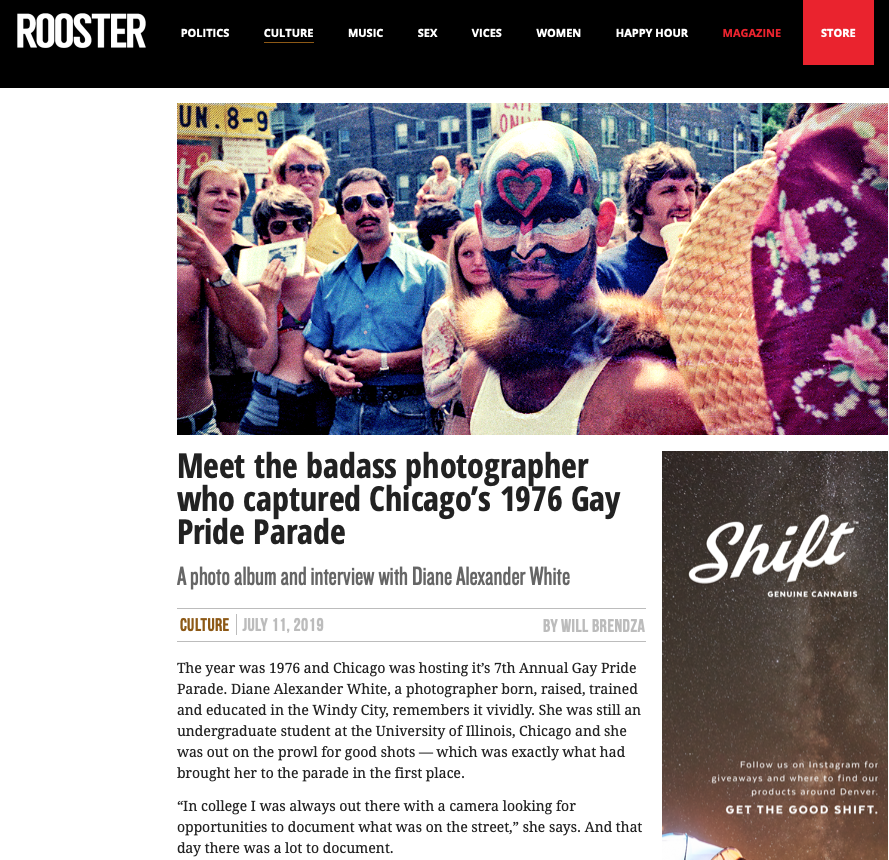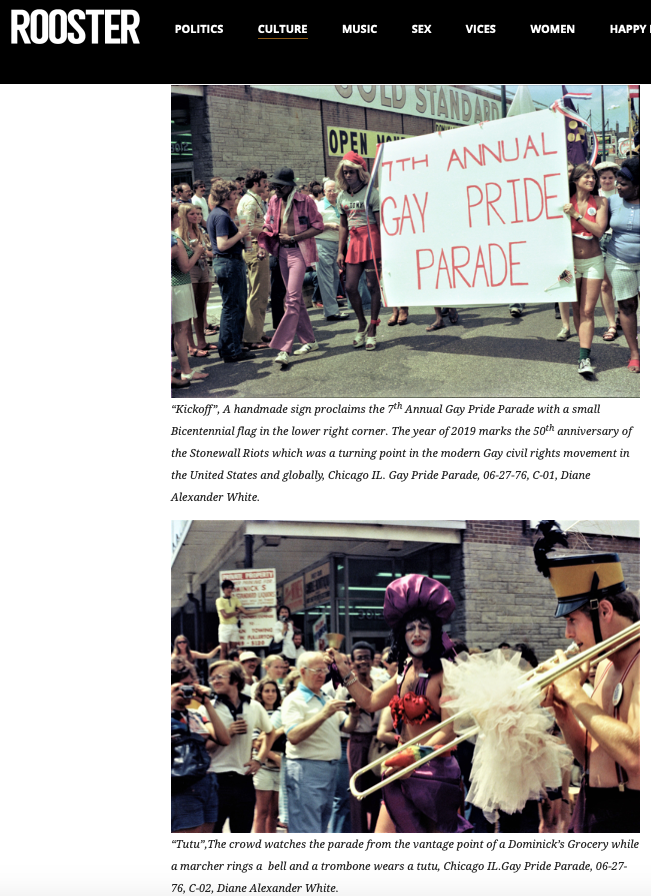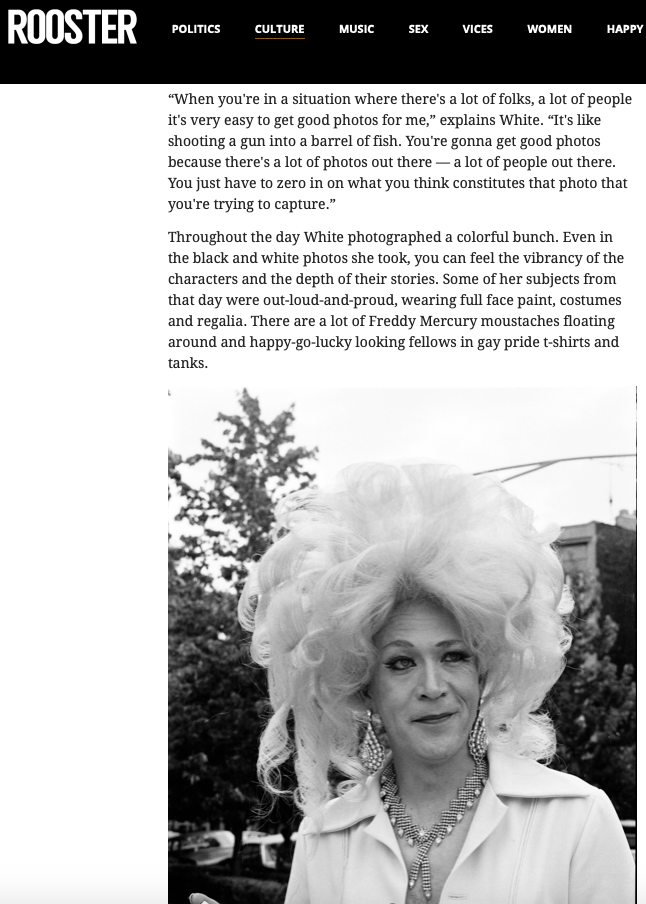“White’s photographs…are an important portal,” Rooster
Posted Sunday, July 21st, 2019 at 4:20 pm
The year was 1976 and Chicago was hosting it’s 7th Annual Gay Pride Parade. Diane Alexander White, a photographer born, raised, trained and educated in the Windy City, remembers it vividly. She was still an undergraduate student at the University of Illinois, Chicago and she was out on the prowl for good shots — which was exactly what had brought her to the parade in the first place.
“In college I was always out there with a camera looking for opportunities to document what was on the street,” she says. And that day there was a lot to document.
“When you’re in a situation where there’s a lot of folks, a lot of people it’s very easy to get good photos for me,” explains White. “It’s like shooting a gun into a barrel of fish. You’re gonna get good photos because there’s a lot of photos out there — a lot of people out there. You just have to zero in on what you think constitutes that photo that you’re trying to capture.”
Throughout the day White photographed a colorful bunch. Even in the black and white photos she took, you can feel the vibrancy of the characters and the depth of their stories. Some of her subjects from that day were out-loud-and-proud, wearing full face paint, costumes and regalia. There are a lot of Freddy Mercury moustaches floating around and happy-go-lucky looking fellows in gay pride t-shirts and tanks.
“I didn’t take out a lot of film,” White says. All she brought with was half a roll of color and some black and white film. “And my tendency is to shoot really quickly — I’m not waiting for the action to come to me, I’m pursuing the action.
“I’m kind of like a tiger looking for its prey,” says White. “I feel like I’m sort of clawing my way through the crowd looking for that next- I don’t know if I’d call them a ‘victim.’” She laughs. “Whoever’s going to be in front of the camera. You know what I mean? I am like pursuing them.”
White didn’t just photograph the stars of that pride parade, though — she also captured a lot of the spectators, boys and girls and men and women, couples and families, some of whom look very happy to be there. Others, who seem out of place. Like in one of White’s favorite images from that day, she titled “Awkward.”
“It is a photo of a family observing the parade while I capture their varied expressions. Dad looks like a fan of country music while Mom on the right wears a wig. The daughter is caught in the middle and appears off guard as the camera clicks the shutter.”
But even that gem isn’t White’s favorite photo of the day. When I asked her which photo was her favorite she responded without hesitation, “The photo of Ray Ray.”
“I found out so much about him,” she says. Years after the parade, her photos were on exhibit, and someone approached her about this particular picture. “A man came up to me named Joey McDonald and he was flipping out. He was saying, ‘Oh my God I can’t believe you photographed my twin. My best friend Ray Ray, this is Ray Ray my best friend.’”
Suddenly, the photo took on an entirely new dimension. Suddenly White knew who this handsome-looking black man, was, who she had photographed so many years ago.
“I was like ‘Oh my gosh I’ve wondered for other for 44 years who this guy is and now I know it’s really Ray Ray Thomas!’ Ramon ‘Ray Ray’ Thomas. He was 21 the same age as myself, which is kind of interesting. We were the same age at that parade that day and he also grew up on the south side.”
Years later, when Ray Ray passed away, White’s photograph would become one of his friends’ dearest memories of him.
Another one of White’s favorite pictures from that day is a photograph of a Native American man, wearing full tribal regalia, Native American bead necklaces, an eagle claw around his neck and a bear claw bracelet. It’s so 70’s, so culturally picturesque, so poignant and awesome. It’s a beautiful photograph.
This collection of photos is a contemplative one. Not just because the images are reminiscent of a strange and beautiful time in the not-so-long ago; but also because they act as a mile-marker, as a landmark to gauge how far we’ve come as a society and as a culture in the years and decades since.
White’s photographs of the 1976 7th Annual Chicago Gay Pride Parade are an important portal, a valuable window into our past, and perhaps even into our future. They immortalize a moment in history that would have otherwise been lost like smoke in the wind.
If you are into White’s photography, check out her website. The ’76 Pride Parade wasn’t her only achievement as a photographer. She also covered the infamous 1979 Disco Demolition Rally, and a whole host of other parades, festivals and celebrations throughout urban Chicago, through the 70’s, 80’s, 90’s and 2000’s, right up into the present day.
White worked for the Chicago Field Museum for 25 years. In addition to photographing several of their natural history collections, White has compiled a number photography exhibits focusing on Native American artifacts. Those exhibits, titled, “With Patience and Good Will: The Art of the Arapaho,” “Cheyenne Visions” and “Travels of the Crow: Journey of an Indian Nation” have been featured in a number of other museums and on tribal lands of the Plains Indians.
Today, she still lives in Chicago and does a lot of freelance corporate shoots when she isn’t pursuing her passion of urban photography.
Click here to read the full article on Rooster Magazine’s website.
By submitting a comment here you grant White Mystery a perpetual license to reproduce your words and name/web site in attribution. Inappropriate or irrelevant comments will be removed at an admin's discretion.










